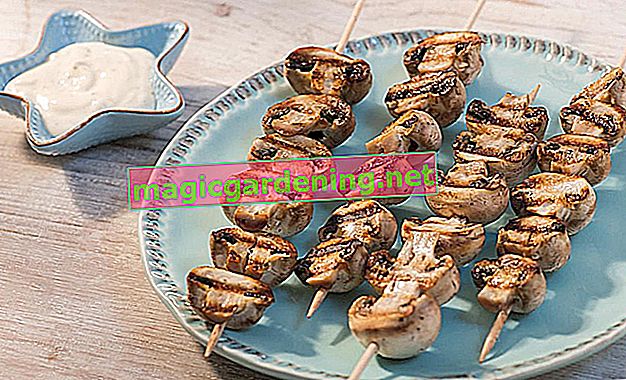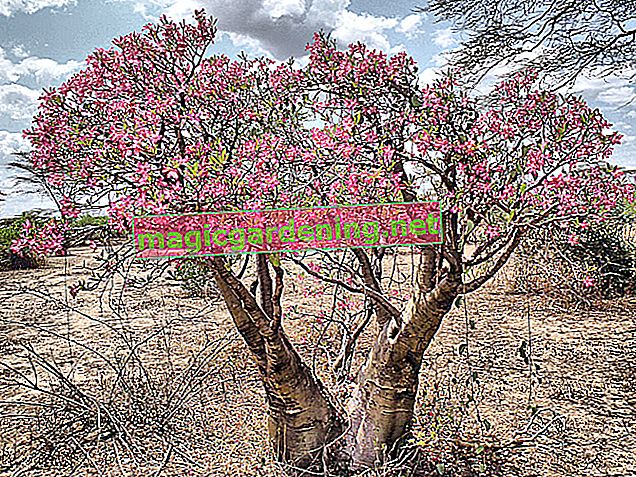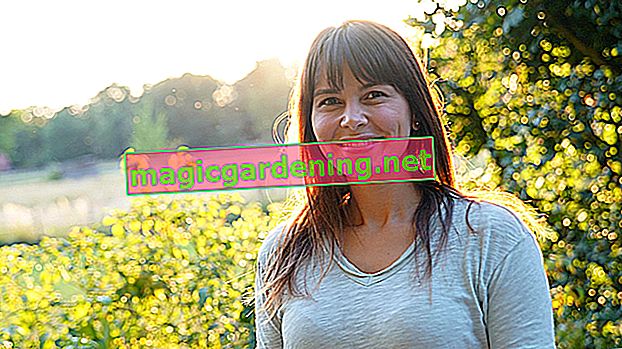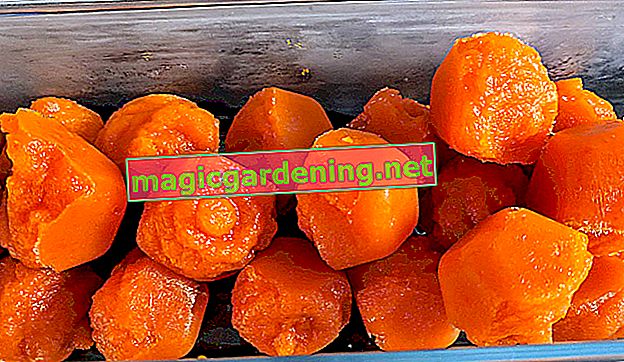
Types of cuts and dates at a glance
An exuberant variety of splendid clematis species and varieties make pruning appear to be a complicated undertaking. Indeed, some clematis are seldom or rarely pruned, while others require radical pruning. The flowering time is an important point of reference for the time of cutting and the procedure. The following table includes all important pruning types with recommended dates for the most popular clematis.
also read
- When should a clematis be pruned?
- How to properly prune clematis montana 'Rubens'
- Cutting clematis in autumn - how to do it right
| Clematis flowering time | Cut type | best date | Cut type | best date | Cut type | best date |
|---|---|---|---|---|---|---|
| Early flowering species | Plant pruning | after planting | Clearance and preservation cut | after the flowering period in May / June | Taper cut | Early November to late February |
| Summer flowering species | Plant pruning | after planting / the following spring | Conservation cut | November to January | Taper cut | November to January |
| Species that bloom twice | Plant pruning | after planting / the following spring | Conservation cut | November to January and June | Taper cut | at 5-year intervals in November / December |
Experienced clematis gardeners will notice the postponement of dates for summer and twice-flowering species. Until a few years ago, February was considered the ideal time for conservation pruning. In the course of global warming, experienced experts advocate pruning the clematis species mentioned between November and January. Mild winter climate leads to an early budding, which falls victim to the shear in February.
background
Legislators have the last word when choosing dates
The termination of strong cutbacks to the winter time is not only based on progressive global warming. Since the amendment to the Federal Nature Conservation Act in 2010, it has been prohibited to radically prune all types of wood between March 1 and September 30. The reason for the determination is the protection of wild animals such as breeding birds. During the summer grace period, light maintenance cuts may be carried out, provided that the measure does not disturb or drive away animals. In order to emphasize the provision, violations can result in severe fines of up to 50,000 euros.Plant pruning - pruning applies to all types of clematis
Regardless of the time of planting or the subsequent flowering times, you should overcome all scruples and give your clematis a vigorous pruning. The pruning measure aims to create a dense branching at the base of the young plant, which can only be made up for by subsequent pruning as part of a radical rejuvenation. This is how expert plant pruning succeeds on all clematis species:
- The best time is immediately after planting
- Cut back all shoots to within 20 or 30 centimeters above the ground
- Measure the cutting height so that a pair of buds remain
If you plant a flowering clematis in the ground as a container plant in summer, please make up for the pruning in November or December. The last date to benefit from the advantages of the top pruning is in February / March after the planting year. In the case of spring-flowering clematis, the cut is at the expense of the next flowering period. Nevertheless, we recommend that you forego the few flowers in favor of a long-term, richly branched clematis in premium quality.

background
Plant pruning is based on botanical growth law
Are you wondering why a clematis' response to pruning is predictable? The reason is the growth law of peak funding, which enables a reliable forecast. The central statement consists in the knowledge that a top bud sprouts disproportionately more strongly than buds lying deeper. The cause is the intense flow of sap towards the top of the plant to force growth towards the light. If the top bud falls away, the excess sap flow is distributed over the remaining buds. The highest standing eyes are given priority. Since the pruning of clematis leaves a single pair of buds, the sap pressure is concentrated at this point and causes sustainable budding at the base of the bush.Little pruning of early bloomers - instructions for maintenance pruning
Popular species such as clematis (Clematis alpina) or clematis (Clematis montana) and their varieties, as well as most wild species, develop their flower dress in spring. The plants planted the buds for the floral festival last year, often immediately after the flowering period. Pruning is tricky on early-blooming clematis because it could destroy the flower systems. Since the clematis of this category naturally remain vital for many years, a cut is not part of the regular maintenance program anyway. If the splendid specimens grow over your head, bloom sparsely or withered, a maintenance cut awakens the floral spirits. How to do it right:
- The best time is when it is fading, by June at the latest
- Cut back too long, balding or damaged shoots by a third or half
- Cut above one pair of outward facing eyes
- Cut off dead branches at the roots
The subsequent time window is sufficient for vigorous growth and for budding for the next year. As the illustration below demonstrates, ideally you should not cut back all shoots equally, but limit the scope to what is absolutely necessary.

Rejuvenate early bloomers - when and how to do it right
An early-blooming clematis does not protect its natural vitality from the floral signs of age. When the branches grow old, bare from below and every single blossom is a sensation, you can no longer avoid a rejuvenating cut. This is how the revitalization works with scissors and a saw:
- The best time is between November and January
- Alternative dates in February to March 1st
- At the beginning, clear out the dead wood
- Cut back the remaining shoots to a length of 30 to 60 centimeters
- Place scissors or saw above buds or sleeping eyes
Round off the rejuvenation cut with a generous portion of compost and horn shavings. (€ 6.39 at Amazon *) Give 3 liters of ripe leaf compost with 100 grams of horn shavings per square meter of root disc and pour in plenty. Alternatively, you can get the growth going with a special clematis fertilizer such as Kölle's Beste or Cuxin DCM.
Digression
Decorative underplanting disguises the bare shrub base
Clematis species that are rarely cut, such as Clematis montana and other early bloomers, tend to have a bare bush base. By planting the root disc with perennials that are not very competitive, you take the gap out of sight. Blue pillows, marigolds, elf flowers and purple bells are suitable as underplanting. Because all clematis want a shady base and a sunny crown, species and varieties that are cut every year also benefit from the floral, shady foot folk.Cut summer bloomers vigorously - Instructions for maintenance pruning
In the partially shaded location, the Italian clematis (Clematis viticella), the golden clematis (Clematis tangutica), the common clematis (Clematis vitalba) and their breathtaking hybrids such as 'Jackmanii' bloom tirelessly from June to October. As is characteristic of summer flowering shrubs, buds and flowers appear on this year's wood. After pruning, pruning follows special rules that take this growth into account. How to do it right:
- The best time is between November and January
- Rigorously cut back all shoots to 10 to 30 centimeters
- Carefully pull the cut branches out of the climbing aid
The illustration below illustrates the powerful pruning of clematis in summer. The aim of the cut is the growth of this year's long shoots. The longer a new shoot thrives in summer, the more flowers it will have. Combine the maintenance pruning with a nutrient supply in February / March to optimize the result.

Digression
Cut perennial clematis like summer flowers
Some of the most magnificent species of clematis do not climb or lignify. Clematis integrifolia and the varieties that emerge from it bloom between June and September on this year's, stiffly upright, unwooded shoots. In winter the plants freeze back, as the gardener knows from herbaceous perennials. Cutting back to 20 centimeters between November and January creates space for fresh budding in early spring. Consequently, with regard to pruning, perennial clematis should be treated like their climbing, woody conspecifics with summer flowering.Rejuvenate aged summer-blooming clematis - this is how it works
Gardeners rarely have to complain about aging and balding of summer-blooming clematis. The strong maintenance cut looks like a continuous rejuvenation. If you missed the pruning care for a few years or inherited an uncut clematis, you can turn back time with this pruning:
- In November / December, shorten the entire climbing bush to 20 centimeters
- Result: the shoot pieces gradually dry back
- Result: fresh shoots from the rhizome
Do not cut the overaged branches off at ground level, otherwise they will dry up to the roots and will no longer sprout.
Tips
If a summer-flowering clematis ends its flowering period as early as July, this is not an indication of aging. Under the influence of many hours of sunshine and high temperatures, the clematis has simply worn out. Cut the climber back again at the beginning of August, drive them out again immediately and shine with new flowers in mid-September.
It is best to cut twice that bloom twice
Clematis, which bloom twice a year, pose a challenge to the pruning. The opulent hybrids with double flowers are prime examples of this floral masterpiece. The climbing shrubs complete the first flowering date from May to June with short shoots that sprout from the wood of the previous year. The second flower pile from August to September unfolds on this year's long shoots and appears as unfilled flowers. This is how you master the maintenance cut with flying colors:
- The best time for the first cut is between November and January
- Shorten climbing tendrils by a third or a quarter
- Cut back clematis by half
- The best time for the second cut is in June
- Cut off withered flowers to the next pair of leaves
The focus of pruning is on the annual shoots with their short, lateral branches. This is where the lush, double clematis flowers present themselves in early summer. The less of the valuable blossom wood that is preserved, the more splendid the appearance. The late summer blooms benefit when the withered flowers are cleaned up. The clematis invests no energy in the growth of seed heads but directs the forces into new flowers.

background
To distinguish between types of shoots means to optimize the cutting result
If you shorten all the shoots by half for winter pruning according to the instructions above, you haven't done anything wrong. An acceptable number of the already established flower buds remains for the first flower pile. You can significantly increase the abundance of flowers by being selective in the pruning. Spare annual, bud-bearing branches entirely from pruning. You can identify the valuable blossom wood with its lush, double flowers by its almost unbranched growth. At the time of the conservation pruning, the withered branches from the previous year are perennial and clearly branched, so that they are cut back by half. On the resulting shoots, the second flower pile with simple flowers appears in summer.Regularly rejuvenate twice-blooming clematis - step-by-step instructions
Moderate pruning on twice-flowered clematis inevitably results in premature aging. An impenetrable tangle forms as old, young and dead shoots, which call for the gardener's organizing hand. Use scissors and a saw to put a stop to the aging process by making a rejuvenating cut at 5-year intervals. How to proceed professionally step by step:
- Cut back all shoots to a height of 30 to 50 centimeters
- Ideally, choose a pair of sleeping eyes as a starting point for scissors or a saw
- Do not cut dead wood at floor level, but shorten it to 20 centimeters
There is no need to worry if all the shoots dry out immediately. Unperturbed, continue the supply of nutrients and water, even if no more ground shoots can be seen afterwards. Under normal conditions, you can look forward to a vital shoot and a rejuvenated clematis in the next spring, at the latest in the spring after next.
Digression
The perfect cut starts near the buds
Clematis thrive with opposite buds. This requires special cutting techniques as part of the maintenance of the cut. A vital shoot relies on you to cut a short distance from two opposite eyes. Ideally, place the scissors 3 to 5 millimeters above a pair of buds. If you cut too far away, the shoot stump will hinder budding. Cut too close or into the buds, dry them out and die. Hold the scissors at a slight angle away from the pair of buds so that rain and irrigation water run off quickly.frequently asked Questions
Are all clematis hardy?
With a few exceptions, clematis species and varieties are very hardy. Light winter protection is recommended for Clematis florida, Clematis texensis and evergreen species such as Clematis armandii. Long-lasting winter wetness in the bed is more problematic than severe frost. It is therefore advisable to cover the root disc with needle twigs to catch hail, snow and continuous rain. In the bucket, the hardiness of clematis is limited due to the exposed position of their root balls. Before winter sets in, wrap the vessels with fleece, jute or bubble wrap and slide a block of wood under the bottom of the pot.
Are clematis poisonous?
Clematis hold a poisonous secret. The magnificent flowering plants are unfortunately flooded with poisonous protoanemonin and other toxins. A brief skin contact is enough to torment the affected gardener with allergic reactions. Eating flowers, fruits, or leaves causes nausea and vomiting. Animals are also not immune from the toxins. Therefore, please choose the location for clematis out of the reach of children and animals. Wear protective clothing during maintenance and cutting work. As a precaution, dispose of the clippings in the organic waste bin and not on the compost.
How can I tell from the leafless clematis shoot whether it is still alive?
When clematis are in their hibernation, they have no leaves and appear lifeless. Perform the vitality test so that you can distinguish living wood from dead wood. To do this, cut off a piece of shoot and check the cross section to make sure that the inside is still green and juicy. If, on the other hand, brown, dry tissue appears, you can thin out the branch.
When is the best time to plant clematis?
Experienced clematis experts, such as Germany's leading clematis breeder, Friedrich Manfred Westphal, advocate late summer and early autumn as the best time to plant. During the months of August, September and October, young clematis find the ideal framework conditions. At a soil temperature of 14 to 20 degrees Celsius, the plants take root quickly and start their first gardening season in spring with a vital growth advantage.
The leaves of my evergreen clematis turned brown in winter. Should I remove the foliage or cut back the entire plant?
Evergreen clematis respond to blazing winter sun and severe frost with brown, withered leaves. Remove the frozen leaves and strengthen the clematis with fertilizer so that it will sprout fresh leaves. If you cut back the plant now, this year's flowering will fail. Evergreen species do it, such as Clematis montana, Clematis alpina or also rhododendrons and forsythia; they plant the buds for the next flowering period in the summer of the previous year.
Clematis with clematis wilt - what can I do?
Gardeners have so far been at a loss against clematis wilt. The fatal disease is triggered by a fungal pathogen that has so far proven to be resistant to pesticides. For this emergency situation, the pair of buds is intended as an iron reserve that you put in the ground when planting. Cut the affected clematis just above the ground and apply a good fertilizer. The defenses of the plant decide whether a new sprout starts. Make sure you have a balanced supply of water and nutrients while you wait. If you don't want to bother with clematis wilt in the future, plant the Italian clematis (Clematis viticella) and the varieties that have emerged from it, which are largely spared from the disease.
My clematis comes from the new Envipo breeding line. What should be considered when pruning?
The magical novelties in the realm of clematis inspire with huge, lushly double flowers. The flowering period extends from June to October. The rules for summer-flowering species and varieties result from this for pruning. Between November and December, cut all shoots back to within 30 centimeters. Buds for next year's flowering spectacle only appear when they are fresh, so you can't go wrong with a wintry appointment.
The 3 most common mistakes
The pruning of clematis seems complicated at first glance. Do not let the different cuts and times stop you from integrating the top-class flower beauty into your garden design. Act on the principle that "practice makes perfect". Thanks to a good-natured cut tolerance, most cutting errors can be eliminated within a short time. The following table will help you avoid the three most common mistakes:
| Cut type | Damage | Prevention / Correction |
|---|---|---|
| Early flowering species cut in late winter | Total failure of this year's heyday | Cut spring flowers in May / June |
| Summer flowering species never cut | few flowers, premature aging | Cut back the summer bloomers vigorously every year |
| no plant pruning | sparse branching at the base of the bush | Shorten all shoots to 20-30 cm after planting |
Tips
In the case of refined clematis varieties, the game root can sometimes drift through. From the root disc, upright wild shoots sprout, which dispute the water and nutrient supply for the precious part. You can identify the strong-growing water shoots by a different form of foliage as well as by large, significantly larger leaf spacings, called internodes. Remove wild shoots as quickly as possible so that they do not overgrow the noble clematis.








